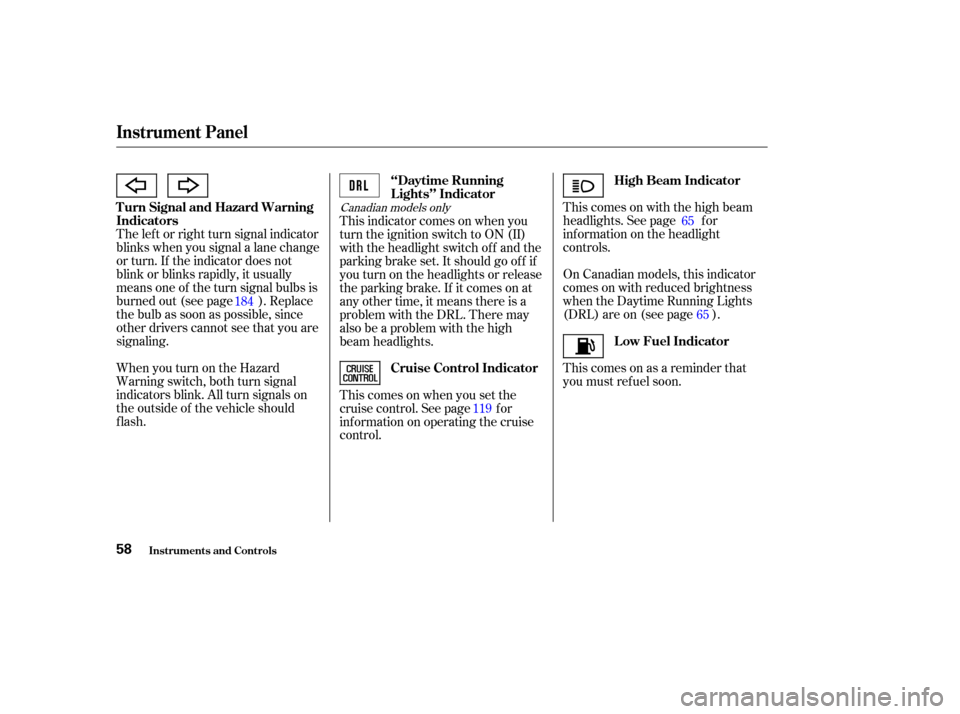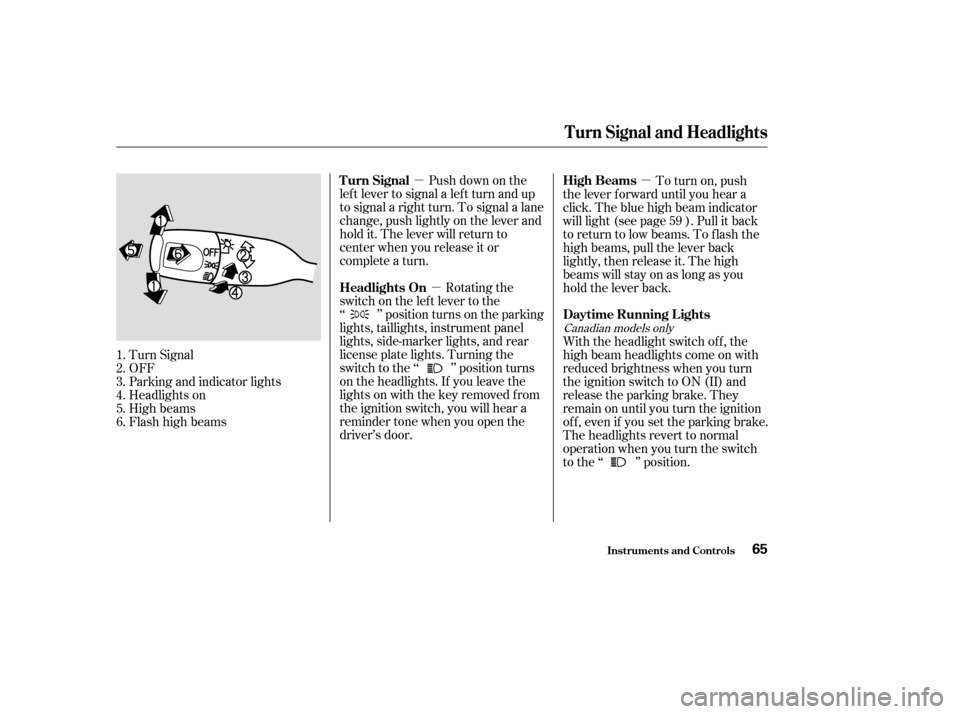Page 55 of 256
These labels are in the locations
shown. They warn you of potential
hazards that could cause serious
injury. Read these labels caref ully. If
a label comes of f or becomes hard to
read, contact your Honda dealer f or
a replacement.
CONT INUED
U.S. models onlyCanadian models
U.S. models
U.S. models only
Saf ety L abels
Driver and Passenger Saf ety51
SUN VISOR
DASHBOARD SUN VISOR
Page 56 of 256
On models without side airbagsOn models with side airbags
Saf ety L abels
Driver and Passenger Saf ety52
HOOD
RADIATOR CAP
Page 57 of 256

This section gives inf ormation about
the controls and displays that
contribute to the daily operation of
your Honda. All the essential
controls are within easy reach............................
Control Locations .54
............................
Instrument Panel .55
.............................................
Gauges .61
...................................
Trip Meter .61
.....................................
Odometer .61
..................................
Fuel Gauge .61
...................
Temperature Gauge . 62
Outside Temperature ..................................
Indicator .62
Controls Near the Steering .......................................
Wheel .63
......................
Wipers and Washers .64
.........
Turn Signals and Headlights . 65
........
Instrument Panel Brightness . 66
.................
Hazard Warning Button . 66
.................
Rear Window Def ogger . 66
.................................
Parking Brake .67
..........
Steering Wheel Adjustment . 68
...............................
Keys and Locks .69
........................
Immobilizer System .70
................................
Ignition Switch .71
......................................
Door Locks .72
......................
Power Door Locks .72
..............
Childproof Door Locks . 72
...........
Tailgate and Hatch Glass . 73
.......................
Remote Transmitter .74 ....................................
Seat Heaters .76
.................................................
Seats .77
........................
Seat Adjustments .77
Driver’s Seat Height ..............................
Adjustment .78
......................................
Armrests .78
..........................
Head Restraints .79
..........
Reclining the Front Seats . 80
...
Folding the Rear Seats Down . 81
..........
Folding the Rear Seat Up . 82
.....................
Detachable Anchor .84
..............................
Power Windows .86
........................................
Grove Box .87
.........................................
Moonroof .88
.............................................
Mirrors .89
....
Adjusting the Power Mirrors . 89
................
Power Mirror Heaters . 90
...........
Interior Convenience Items . 91
.............................
Beverage Holder .92
...................................
Built-in Table .92
.....................................
Storage Box .94
..........................
Sunglasses Holder .94
....................................
Center Table .94
..............
Accessory Power Sockets . 95
Instruments and Controls
Inst rument s and Cont rols53
Page 62 of 256

On Canadian models, this indicator
comes on with reduced brightness
when the Daytime Running Lights
(DRL) are on (see page ). This comes on with the high beam
headlights. See page f or
inf ormation on the headlight
controls.
Thiscomesonasareminderthat
you must ref uel soon.
The lef t or right turn signal indicator
blinks when you signal a lane change
or turn. If the indicator does not
blink or blinks rapidly, it usually
means one of the turn signal bulbs is
burned out (see page ). Replace
the bulb as soon as possible, since
other drivers cannot see that you are
signaling.
WhenyouturnontheHazard
Warning switch, both turn signal
indicators blink. All turn signals on
the outside of the vehicle should
flash. This indicator comes on when you
turn the ignition switch to ON (II)
with the headlight switch off and the
parking brake set. It should go of f if
youturnontheheadlightsorrelease
the parking brake. If it comes on at
any other time, it means there is a
problem with the DRL. There may
also be a problem with the high
beam headlights.
Thiscomesonwhenyousetthe
cruise control. See page f or
inf ormation on operating the cruise
control.
184
11965
65
Canadian models only
Inst rument s and Cont rols
Instrument Panel
Turn Signal and Hazard Warning
Indicators
‘‘Daytime Running
Lights’’ Indicator
High Beam Indicator
Low Fuel Indicator
Cruise Control Indicator
58
Page 65 of 256

This shows the total distance your
vehicle has been driven. It measures
miles in U.S. models and kilometers
in the Canadian models.
It is illegal under U.S. f ederal law and
Canadian provincial regulations to
disconnect, reset, or alter the
odometer with the intent to change
the number of miles or kilometers
indicated.
This shows how much f uel you have.
It may show slightly more or less
than the actual amount. The needle
returns to the bottom after you turn
of f the ignition.
There are two trip meters: Trip A
and Trip B. Switch between these
displays and the odometer/outside
temperature display (Canadian
models only) by pressing the Select/
Reset button repeatedly. This shows the number of miles (U.S.)
or kilometers (Canada) driven since
you last reset it.
Each trip meter works independently, so you can keep track of two
dif f erent distances.
To reset a trip meter, display it, and
then press and hold the Select/Reset
button until the number resets to
‘‘0.0’’. Both trip meters will reset if
the vehicle’s battery goes dead or is
disconnected.Odometer
Trip Meter Fuel Gauge
Gauges
Inst rument s and Cont rols61
SELECT/RESET BUTTON
TEMPERATURE GAUGE SPEEDOMETER
ODOMETER/TRIP METER
TACHOMETER
FUEL GAUGE
Avoid driving with an extremely low
f uel level. Running out of f uel could
cause the engine to misf ire, damaging
the catalytic converter.
Page 69 of 256

�µ�µ �µ
Push down on the
lef t lever to signal a lef t turn and up
to signal a right turn. To signal a lane
change, push lightly on the lever and
hold it. The lever will return to
center when you release it or
complete a turn.
Rotating the
switch on the lef t lever to the
‘‘ ’’ position turns on the parking
lights, taillights, instrument panel
lights, side-marker lights, and rear
license plate lights. Turning the
switch to the ‘‘ ’’ position turns
on the headlights. If you leave the
lights on with the key removed f rom
the ignition switch, you will hear a
reminder tone when you open the
driver’s door. To turn on, push
the lever f orward until you hear a
click. The blue high beam indicator
will light (see page ). Pull it back
to return to low beams. To flash the
high beams, pull the lever back
lightly, then release it. The high
beams will stay on as long as you
hold the lever back.
With the headlight switch off, the
high beam headlights come on with
reduced brightness when you turn
the ignition switch to ON (II) and
release the parking brake. They
remain on until you turn the ignition
of f , even if you set the parking brake.
The headlights revert to normal
operation when you turn the switch
to the ‘‘ ’’ position.
Turn Signal
OFF
Parking and indicator lights
Headlights on
High beams
Flashhighbeams
1.
2.
3.
4.
5.
6. 59
Canadian models only
Turn Signal
Headlights On
High Beams
Daytime Running L ights
Inst rument s and Cont rols
Turn Signal and Headlights
65
Page 71 of 256
To release the parking brake, push
andholdthereleasebuttononthe
side of the parking brake lever, pull
the lever toward you slightly, then
push the lever f orward.
To apply the parking brake, f irmly
pull the parking brake lever toward
you.
Make sure the rear window is clear
and you have good visibility bef ore
starting to drive.
Thedefoggerwiresontheinsideof
the rear window can be accidentally
damaged. When cleaning the glass,
always wipe side-to-side.
The parking brake light on the
instrument panel should go out.
Parking Brake
Rear Window Def ogger, Parking Brake
Inst rument s and Cont rols67
NOTICE:
PARKING BRAKE
LEVER
RELEASE BUTTON
Driving the vehicle with the
parking brake applied can damage the
rear brakes and axles.
Page 74 of 256

If the system repeatedly does not
recognize the coding of your key,
contact your Honda dealer.
Do not attempt to alter this system
or add other devices to it. Electrical
problems could result that may make
your vehicle undriveable.
If you have lost your key and cannot
start your engine, contact a Honda
dealer.
The Immobilizer System protects
your vehicle f rom thef t. If an
improperly-coded key (or other
device) is used, the engine’s f uel
system is disabled.
When you turn the ignition switch to
ON (II), the Immobilizer System
indicator should come on f or a f ew
seconds, then go out. If the indicator
starts to blink, it means the system
does not recognize the coding of the
key. Turn the ignition switch to
LOCK (0), remove the key, reinsert
it, and turn the switch to ON (II)
again.
The system may not recognize your
key’s coding if another immobilizer
key or other metal object is near the
ignition switch when you insert the
key.As required by the FCC:
This device complies with Part 15 of theFCC rules. Operation is subject to thef ollowing two conditions: (1) This devicemay not cause harmf ul interf erence, and(2) this device must accept anyinterf erence received, includinginterf erence that may cause undesiredoperation.
Changes or modif ications not expresslyapproved by the party responsible f orcompliance could void the user’sauthority to operate the equipment.
This device complies with IndustryCanada Standard RSS-210.Operation is subject to the f ollowing twoconditions: (1) this device may not causeinterf erence, and (2) this device mustaccept any interf erence that may causeundesired operation of the device.
Immobilizer Syst em
Inst rument s and Cont rols70